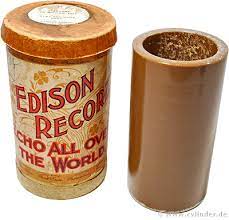Phonograph
The Phonograph is the peak of sound recording and reproduction, recording on the finest audio format known to humankind: empty toilet paper roll. Not Vinyl, nor cassettes, or anything invented after the phonograph. Its inability to sound any better than a shitty telephone forces listeners to listen closer and appreciate its lack of nuance, detail or frequency response.
History[edit | edit source]
In 1850, Édouard-Léon Scott de Martinville created a device called the phonautograph that records sound by etching a sound wave into soot covered paper. His intent was to make the sound waves into a form of writing, but surprise surprise, people cannot read sound waves.
In 1877, Thomas Edison realized that Édouard-Léon Scott de Martinville's invention was indeed fucking stupid because apparently, people's ears can interpret sound waves into words, but not the eyes. Edison then changed out the soot covered paper with tinfoil and began testing. However, upon playing back his voice, he was shocked at what his voice really sounded like as opposed to what it sounded like in his head. This led him to throw his phonograph out the window and instead focus on the light bulb.
Alexander Graham Bell had happened to stand below the window where Edison threw out his phonograph, caught it, and took it home. There, he got his cousin, Chichester Bell and a physicist, Charles Sumner Tainter, to rip off Edison's phonograph, and came up with the Graphophone in 1886, which recorded on big, long, hard, smooth... erm... wax tubes.
Edison was shocked that SOMEONE did SOMETHING with HIS invention that HE had done absolutely nothing with for 9 years. When he started to work on the phonograph again in reaction, he realized that he ran out of both tinfoil to record sound with, and toilet paper. He ended up replacing the tinfoil with an empty toilet paper roll (left) with his phonograph, called it "good enough", and released it out into the general public in 1890. He later made several improvements, such as dyeing the rolls black in 1902, or blue in 1912.
Unfortunately for him, the shellac disc record invented by Emile Berliner in 1887 and popularized in the 1890s, started to compete with Edison's phonograph. In response, he invented the Diamond Disc phonograph in 1912, which he seems to regret based on the image to the right. However, it was not until 1929 with the stock market crash that Edison went out of business. The shellac record remained popular and was superseded by Vinyl in the 1950s.


